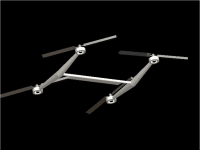Flying electric generators (FEGs) are designed to harness kinetic energy in the powerful, persistent high altitude winds. At 15,000 feet (4600 m) and above, tethered rotorcraft, with four or more rotors mounted on each unit, could give individual rated outputs of up to 40 MW. These aircraft would be highly controllable and could be flown in arrays, making them a large-scale source of reliable wind power. It is anticipated that large-scale units would make low cost electricity available for grid supply. Tethered rotorcraft, with four or more rotors in each unit, could harness the powerful, persistent jet streams, and should be able to compete effectively with all other energy production methods. One of the challenges to be faced in this design is the stability of the tether which is to be used. At one side it should be strong enough to hold the FEG in its position and at the same time it should not be rigid like a rod and should be flexible. It should also satisfy the condition of electrical conductivity to bring the generated power to the ground. All these conditions together can be satisfied by the application of carbon nanotube (CNT) based tethers. So in this paper an approach has been given to use CNT based tethers for these FEGs. The extreme strength of CNT coupled with its flexibility can proved to be a real gear.
The extreme strength of CNT coupled with its flexibility can proved to be a real gear up for making the concept of FEGs real and feasible. All the technological details regarding the working mechanism of this system along with its control, cost and performance details has been discussed. Also the information on the carbon nanotubes, its effective synthesis and properties has been included. Along with these details another approach of making this system a hybrid one also has been given. This can be done by incorporating solar panels on the surface of this system to harness solar energy, which is also (like wind) available in plenty in nature, and thus can increase the net power output. This design works similar to air foil so that it requires less energy to lift to high altitude.
Like this entry?
-
About the Entrant
- Name:Kannan Pandi
- Type of entry:individual
- Patent status:none





